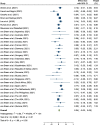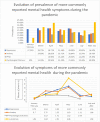The global evolution of mental health problems during the COVID-19 pandemic: A systematic review and meta-analysis of longitudinal studies
- PMID: 35842064
- PMCID: PMC9278995
- DOI: 10.1016/j.jad.2022.07.011
The global evolution of mental health problems during the COVID-19 pandemic: A systematic review and meta-analysis of longitudinal studies
Abstract
Background: The COVID-19 pandemic impacted mental health, but the global evolution of mental health problems during the pandemic is unknown. We conducted a systematic review and meta-analysis of longitudinal studies to evaluate the global evolution of mental health problems during the pandemic.
Methods: To conduct this systematic review, we searched for published articles from APA PsycInfo (Ovid), CINAHL (EBSCOhost), Embase (Ovid), MEDLINE (Ovid), and Web of Science. Longitudinal (at least 2 waves during the COVID-19 pandemic) and peer-reviewed articles on mental health problems conducted as from 2020 and after were included in the current study. Of 394 eligible full texts, 64 articles were included in the analysis. We computed random effects, standardized mean differences, and log odds ratio (LOR) with 95 % CIs. The meta-analysis protocol was registered with PROSPERO (CRD42021273624).
Results: Results showed that anxiety (LOR = -0.33; 95 % CI, -0.54, -0.12) and depression symptoms (LOR = -0.12; 95 % CI, -0.21, -0.04) decreased from baseline to follow up. However, other mental health problems showed no change. Higher prevalence rates (40.9 %; 95 % CI, 16.1 %-65.8 %) of psychological distress were found in months after July 2020, respectively, while there were no significant month differences for the prevalence of other mental health problems. Higher means of anxiety (d = 3.63, 95 % CI, 1.66, 5.61), depression (d = 3.93; 95 % CI, 1.68, 6.17), and loneliness (d = 5.96; 95 % CI, 3.22, 8.70) were observed in May 2020. Higher prevalence of anxiety, depression, and PTSD and higher means of anxiety, depression and loneliness were observed in North America. The prevalence of psychological distress and insomnia was higher in Latin America and Europe, respectively.
Limitations: There is a lack of longitudinal studies in some parts of the world, such as Africa, the Caribbean, India, the Middle East, in Latin America, and Asia.
Conclusions: Results indicated that anxiety and depression symptoms decreased during the COVID-19 pandemic while other mental health problems showed no statistical change. The findings reveal that mental health problems peaked in April and May 2020. Prevalence of mental health problems remains high during the pandemic and mental health prevention, promotion and intervention programs should be implemented to mitigate the consequences of the COVID-19 pandemic on the global population.
Keywords: COVID-19 pandemic; Longitudinal studies; Mental health problems; meta-analysis.
Copyright © 2022 Elsevier B.V. All rights reserved.
Conflict of interest statement
None reported.
Figures
















References
-
- Ahrens K.F., Neumann R.J., Kollmann B., Brokelmann J., Von Werthern N.M., Malyshau A., Weichert D., Lutz B., Fiebach C.J., Wessa M., Kalisch R., Plichta M.M., Lieb K., Tüscher O., Reif A. 2021. Impact of COVID-19 Lockdown on Mental Health in Germany: Longitudinal Observation of Different Mental Health Trajectories and Protective Factors. - DOI - PMC - PubMed
Publication types
MeSH terms
LinkOut - more resources
Full Text Sources
Medical
Miscellaneous

